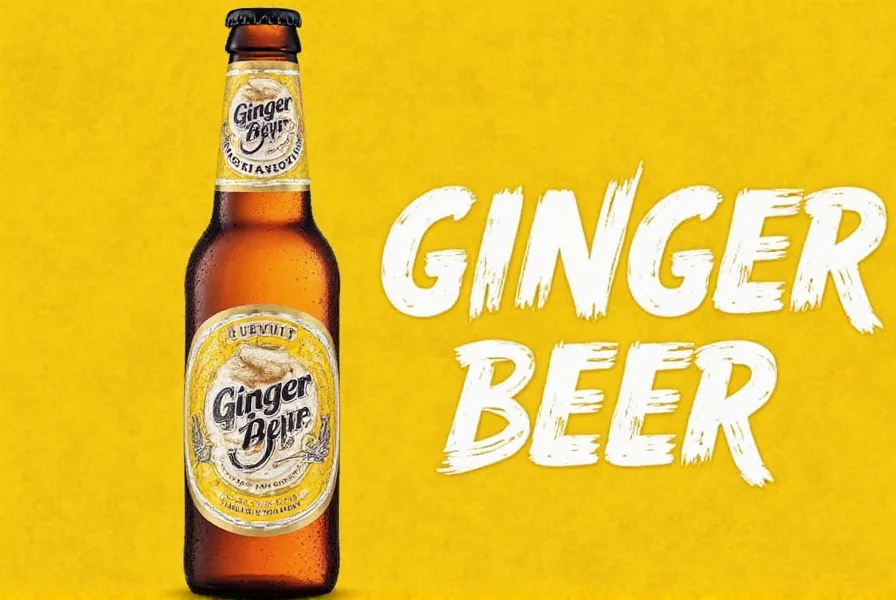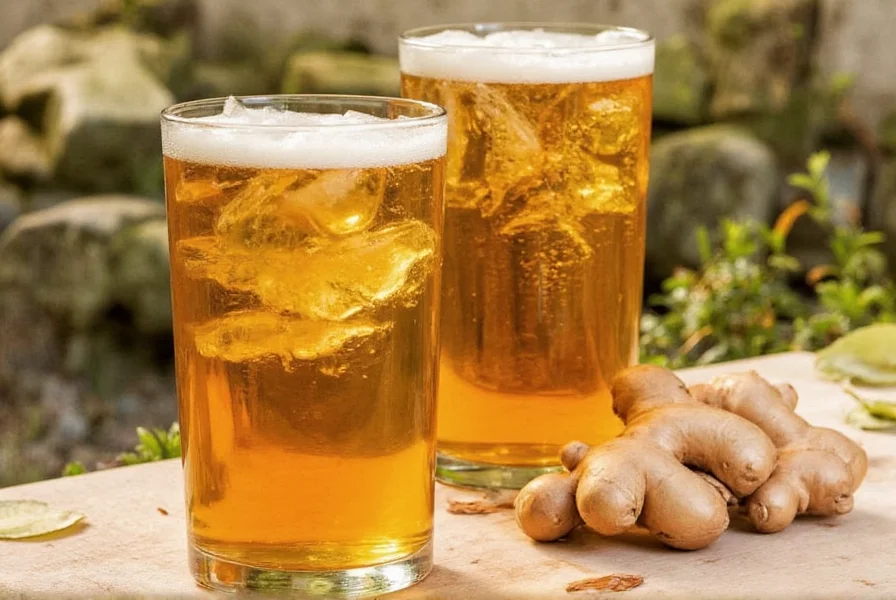The primary health benefits of traditional ginger beer stem from its ginger content, which may support digestion, reduce nausea, and provide anti-inflammatory effects. However, most commercial ginger beers contain minimal ginger and high sugar levels, significantly reducing potential health benefits compared to homemade or craft versions with substantial ginger content. Real benefits come from gingerols and shogaols in fresh ginger, not the carbonated beverages commonly sold as ginger beer today.
When exploring ginger beer benefits, it's crucial to distinguish between traditional fermented ginger beer and modern commercial versions. True ginger beer contains live cultures and substantial ginger root, while most store-bought options are simply carbonated drinks with ginger flavoring and high sugar content. Understanding this difference is essential for evaluating potential health impacts.
What Exactly Is Ginger Beer?
Ginger beer originated as a fermented beverage made from ginger root, sugar, water, and a "ginger beer plant" (a symbiotic culture of bacteria and yeast). Traditional preparation involves a 2-5 day fermentation process that creates natural carbonation and beneficial probiotics. Modern commercial ginger beer, however, is typically a non-alcoholic, artificially carbonated soft drink with minimal actual ginger content.
| Type of Ginger Beer | Ginger Content | Sugar Level | Alcohol Content | Probiotics |
|---|---|---|---|---|
| Traditional fermented | High (20-50g fresh ginger/L) | Moderate (partially consumed in fermentation) | 0.5-3% ABV | Present |
| Craft commercial | Moderate (5-15g/L) | Moderate to high | Non-alcoholic | Absent |
| Mass-market commercial | Low (1-3g/L) | Very high | Non-alcoholic | Absent |
Actual Health Benefits of Ginger Beer
The potential health advantages associated with ginger beer come primarily from its ginger content, not the beverage itself. Research on ginger beer for nausea relief actually refers to ginger's properties, not commercial ginger beer products.
Digestive Support
Ginger has been shown to accelerate gastric emptying, which can relieve symptoms of indigestion. A study published in European Journal of Gastroenterology & Hepatology found that 1.2g of ginger powder taken before a meal reduced feelings of fullness and sped up stomach emptying by 25%. Traditional ginger beer containing similar ginger concentrations may offer comparable ginger beer digestive benefits, though most commercial versions lack sufficient ginger.
Nausea Reduction
Multiple studies confirm ginger's effectiveness against various forms of nausea. Research in Obstetrics & Gynecology demonstrated that 1g of ginger daily significantly reduced pregnancy-related nausea. Another study in Supportive Care in Cancer showed ginger supplements reduced chemotherapy-induced nausea by 40%. For those wondering does ginger beer help with morning sickness, traditional ginger beer with adequate ginger content may provide relief, but sugary commercial versions likely won't.

Anti-Inflammatory Properties
Ginger contains potent anti-inflammatory compounds called gingerols. Research in Journal of Medicinal Food indicates these compounds may reduce inflammation markers by up to 30% in clinical studies. While ginger beer anti-inflammatory benefits are theoretically possible with high-ginger formulations, the sugar content in most commercial products may actually promote inflammation, counteracting potential benefits.
Antioxidant Content
Ginger is rich in antioxidants that combat oxidative stress. A study in Food Chemistry found ginger extracts demonstrated significant free radical scavenging activity. Traditional ginger beer made with substantial fresh ginger would retain some of these antioxidants in ginger beer, though processing and storage reduce potency.
Important Considerations and Limitations
When evaluating is ginger beer good for you, several critical factors must be considered:
Sugar Content in Commercial Products
Most commercial ginger beers contain 30-40g of sugar per 12oz serving—comparable to cola. This high sugar content negates many potential benefits, as excessive sugar intake promotes inflammation and other health issues. For those seeking healthy ginger beer alternatives, low-sugar craft options or homemade versions are preferable.
Difference Between Ginger Beer and Ginger Ale
Ginger ale typically contains even less ginger than commercial ginger beer and is often made with artificial ginger flavor. Traditional ginger beer has a spicier, more complex flavor profile due to higher ginger content and fermentation. When researching ginger beer vs ginger ale health benefits, understand that neither offers significant advantages in their commercial forms, though traditional ginger beer has greater potential benefit.
Alcohol Content in Traditional Versions
Authentic fermented ginger beer contains small amounts of alcohol (0.5-3% ABV). While this is lower than most beers, it's important for those avoiding alcohol for health, religious, or personal reasons. Most commercial products are non-alcoholic, but lack the probiotic benefits of fermented versions.

Maximizing Potential Benefits
If you're interested in the health benefits of homemade ginger beer, consider these approaches:
- Make your own: Using 50g of fresh ginger per liter creates a beverage with meaningful ginger content
- Check labels: Look for craft brands listing ginger near the top of ingredients with minimal added sugar
- Use as mixer: Combine small amounts of strong ginger beer with sparkling water to reduce sugar intake while retaining flavor
- Short fermentation: For homemade versions, 2-3 days provides probiotics without significant alcohol development
Potential Side Effects and Limitations
While generally safe, ginger beer may cause issues for some individuals:
- Heartburn or gastric irritation in sensitive individuals
- Blood thinning effects (caution for those on anticoagulants)
- Lowered blood sugar (caution for diabetics)
- Interactions with certain medications including beta-blockers
Most commercial ginger beers pose minimal risk beyond their high sugar content, while traditional fermented versions with substantial ginger may have more pronounced effects—both positive and negative.
Conclusion
The true benefits of ginger beer come from its ginger content, not the carbonated beverage most people purchase. Traditional fermented ginger beer with substantial fresh ginger offers potential digestive support, nausea relief, and anti-inflammatory effects. However, mass-market commercial versions contain minimal ginger and high sugar levels that negate most potential health advantages. For those seeking natural remedies with ginger beer, homemade versions or carefully selected craft products provide the best balance of flavor and potential benefits without excessive sugar.
Frequently Asked Questions
Does store-bought ginger beer have real health benefits?
Most store-bought ginger beers contain minimal actual ginger (typically 1-3g per liter) and high sugar content (30-40g per serving), significantly reducing potential health benefits. While they provide ginger flavor, they lack sufficient ginger compounds to deliver meaningful digestive or anti-nausea effects compared to traditional preparations with 20-50g of fresh ginger per liter.
Can ginger beer help with upset stomach?
Traditional ginger beer made with substantial fresh ginger (20g+ per serving) may help with upset stomach due to ginger's proven effects on gastric motility. However, most commercial ginger beers contain insufficient ginger and too much sugar, which can actually worsen digestive issues. For ginger beer for upset stomach relief, homemade versions or checking labels for high ginger content is essential.
How does ginger beer compare to fresh ginger for health benefits?
Fresh ginger contains higher concentrations of active compounds (gingerols and shogaols) than most commercial ginger beers. One tablespoon of fresh grated ginger contains approximately 5g of ginger, while a 12oz serving of commercial ginger beer typically contains less than 3g total. Traditional fermented ginger beer with adequate ginger content comes closer to fresh ginger's benefits, but processing and dilution still reduce potency compared to consuming ginger directly.
Is homemade ginger beer healthier than store-bought?
Homemade ginger beer is typically healthier when prepared with substantial fresh ginger (20-50g per liter) and controlled sugar levels. The fermentation process creates beneficial probiotics absent in most commercial versions. However, homemade versions require careful preparation to avoid excessive sugar content or unintended high alcohol levels. The key advantage is control over ingredients—ensuring meaningful ginger content while managing sugar levels for better health benefits of homemade ginger beer.
Can ginger beer help with motion sickness?
Ginger has demonstrated effectiveness against motion sickness, but most commercial ginger beers contain insufficient ginger to be effective. Research showing ginger's benefits for motion sickness typically uses 500mg-1g of ginger—equivalent to 10-20g of fresh ginger. Most commercial ginger beers would require consuming multiple servings (with excessive sugar) to reach this threshold. Traditional ginger beer with high ginger content may help, but fresh ginger or supplements remain more reliable options for ginger beer motion sickness relief.










 浙公网安备
33010002000092号
浙公网安备
33010002000092号 浙B2-20120091-4
浙B2-20120091-4